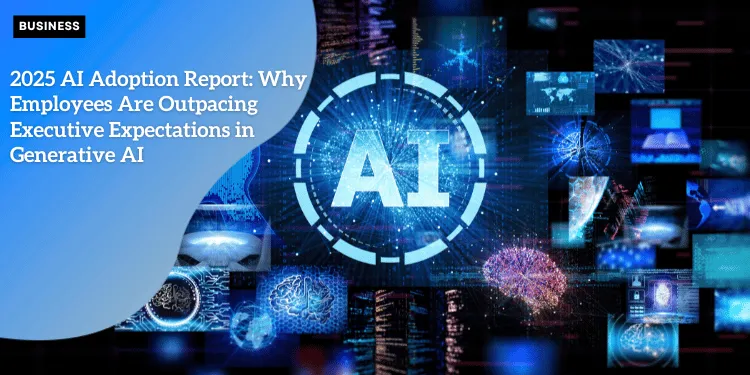2025 AI Adoption Report: Why Employees Are Outpacing Executive Expectations in Generative AI

Anúncios
Disparities Between Employee Adoption and Executive Awareness
The latest data paints a surprising picture of the growing AI expertise gap within organizations.
While executives may have ambitious projections, they often lag in recognizing the rapid pace at which employees are adopting AI technologies.
According to a McKinsey report, 2025 saw a striking disparity, with employees outpacing their leaders in AI adoption and proficiency.
Millennials Leading the Charge in AI Proficiency
Millennials, particularly those aged 35-44, are at the forefront of this trend.
Anúncios
An impressive 62% of professionals in this age group report strong expertise in AI.
This group has grown up in the technology era, making them more adaptable and fearless in experimenting with new tools.
These digital natives are leveraging AI to improve efficiencies and outcomes in their respective roles.
Anúncios
 AI
AI
Cross-Functional Embrace of AI Tools
The enthusiasm for AI isn’t limited to millennials alone.
Employees from a variety of roles are rapidly integrating AI into their workflows faster than anticipated.
From marketing professionals using AI for predictive analytics to financial analysts deploying it for real-time data processing, the adoption of these tools is widespread and accelerating.
The trend suggests that the operational levels of companies recognize the immediate, practical benefits AI can offer, even if the C-suite is slower to acknowledge this progression.
This growing divide between executive expectations and grassroots adoption highlights the need for organizations to align their strategies more closely with the realities on the ground.
Next, we will explore how different industries are navigating AI adoption, with optimism in some sectors and skepticism in others.
Industry-Specific AI Adoption Trends
High Optimism in Media/Entertainment and Telecom Sectors
The media, entertainment, and telecom sectors are leading the charge with AI adoption.
Approximately two-thirds of respondents from these industries anticipate significant AI-driven changes in the near future.
This optimism stems from the sectors’ inherent need for innovation and the growing emphasis on personalization, content creation, and enhanced customer experiences.
Leveraging generative AI, companies in these industries can produce tailored content at an unprecedented speed, automate routine tasks, and improve overall operational efficiency.
Conservative Outlook in Public Sector, Aerospace/Defense, and Semiconductors
Conversely, the public sector, aerospace/defense, and semiconductor industries demonstrate a more conservative outlook toward AI adoption.
Only 20% of the respondents from these sectors expect significant changes due to AI in the next year.
The skepticism is largely attributed to the critical nature of their operations, stringent regulatory environments, and the high stakes involved in adopting new technologies.
For instance, the aerospace/defense sector requires rigorous testing and validation before deploying AI solutions, which can delay adoption.
Sector-Specific Challenges and Opportunities
Each industry faces unique challenges and opportunities with AI adoption:
- Media/Entertainment and Telecom:
| Aspect | Description |
|---|---|
| ⚠️ Challenges | AI in content creation raises concerns about data privacy, content authenticity, and requires significant investment in AI infrastructure. |
| 💡 Opportunities | AI can enhance creative workflows, improve audience targeting, and revolutionize content delivery methods, offering businesses a competitive edge. |
- Public Sector:
| Aspect | Description |
|---|---|
| ⚠️ Challenges | Implementing AI in the public sector faces obstacles like bureaucratic inertia, budget constraints, and the shortage of skilled AI personnel. |
| 💡 Opportunities | AI can streamline public services, enhance decision-making processes, and foster better citizen engagement with more personalized services. |
- Aerospace/Defense:
| Aspect | Description |
|---|---|
| ⚠️ Challenges | AI in critical systems faces challenges like high security requirements, ethical concerns, and the need for rigorous testing protocols. |
| 💡 Opportunities | AI can offer advanced diagnostics, predictive maintenance capabilities, and enhanced situational awareness, improving operational efficiency. |
- Semiconductors:
| Aspect | Description |
|---|---|
| ⚠️ Challenges | AI in hardware development faces challenges such as high research and development costs, integration complexities, and the constantly evolving nature of AI technologies. |
| 💡 Opportunities | AI can enhance chip design processes, improve manufacturing efficiencies, and open doors for the development of AI-optimized hardware solutions. |
Understanding these sector-specific dynamics is crucial for companies aiming to harness the power of AI effectively.
Ensuring tailored strategies that address distinct industry needs will be key to successful AI integration.
As we move forward, the focus will shift to aligning executive expectations with on-the-ground employee expertise, ensuring a cohesive approach to AI adoption.
Executive Expectations and Revenue Projections
Anticipated Revenue Growth from Generative AI
A significant majority of executives—87%—believe that generative AI will drive revenue growth within the next three years.
Among these, half are confident that their organizations will see gains exceeding 5% during this period.
This optimism reflects the perceived transformative potential of AI technologies to impact various aspects of business operations, from efficiency improvements to innovative product development.
Projections Versus Implementation: The Growing Disconnect
The disparity between executive expectations and the current pace of AI implementation by employees suggests a crucial gap in organizational strategy.
While many leaders foresee substantial financial benefits from AI, the actual integration and utilization of these tools at the employee level seem to lag behind.
This gap underscores the necessity for a more aligned approach in deploying AI technologies and ensuring widespread adoption across all levels of the organization.
Transitioning to Greater AI Utilization
For companies to capitalize on the projected revenue boosts, they must bridge this gap between executive vision and on-the-ground execution.
This involves not only investing in AI tools but also fostering an environment where employees are trained, supported, and encouraged to fully leverage these technologies.
Recognizing and utilizing the existing AI expertise within the workforce, particularly among millennials, will be key to realizing these ambitious revenue goals.
As organizations navigate this complex landscape, the focus must shift towards effectively integrating AI expertise and aligning it with executive strategies.
This journey will be influenced by various factors tied to specific industries and roles within the global workforce.
Global Workforce Perspective
A recent survey reveals global trends in AI adoption, highlighting inputs from 3,613 employees and 238 C-level executives across multiple countries.
This diverse representation included respondents from the US, Australia, India, New Zealand, Singapore, and the UK, indicating a wide sample base for understanding AI adoption patterns.
Diverse Geographic Representation
The survey conducted by McKinsey & Company showed that while 81% of respondents were from the United States, perspectives from Australia, India, New Zealand, Singapore, and the UK added depth to the findings.
This diverse geographical representation ensures that the insights reflect a broad spectrum of AI adoption trends and employee experiences with generative AI.
Cross-Functional Adoption Rates
The adoption rates of generative AI varied significantly across different business functions, with notable enthusiasm observed in sectors such as marketing, finance, and technology.
Employees in marketing and product management roles reported higher adoption rates, leveraging AI tools to enhance customer engagement and optimize marketing strategies.
Similarly, finance professionals utilized AI to streamline operations, perform advanced analytics, and bolster fraud detection.
The technology sector, predictably, was at the forefront of this wave, with tech workers adopting AI tools rapidly to drive innovation and product development.
These varying adoption rates emphasize that the integration of AI is not uniform and is heavily influenced by the specific demands and opportunities within each business function.
Generational Expertise
Interestingly, millennials aged 35-44 demonstrated a strong command of AI technologies, with 62% reporting proficiency.
This generational expertise highlights millennials as key players in driving AI adoption within their organizations.
Their familiarity and comfort with AI tools are proving pivotal in integrating these technologies into daily operations.
To capitalize on this generational expertise, organizations must recognize and support the potential of millennials, providing continuous learning opportunities and encouraging innovation.
Bridging the Disconnect
While global employees are rapidly embracing AI, there appears to be a disconnect with executive awareness and strategic planning.
Bridging this gap remains crucial for organizations to harness the full potential of generative AI.
Supporting employee-led AI initiatives and fostering a collaborative environment where ground-level insights inform executive strategies will be essential.
As organizations strive to align these efforts, they must focus on integrating AI seamlessly across different business functions, supporting employee expertise, and crafting unified strategies to propel AI-driven growth and innovation.
Future Implications and Recommendations
Bridging the Gap Between Employee Adoption and Executive Strategy
Organizations must urgently address the noticeable gap between employee adoption of AI tools and executive awareness.
Many employees, especially millennials aged 35-44, are already proficient in AI technologies, with 62% reporting strong expertise.
This disparity highlights an opportunity for executives to realign their strategies to better support their workforce’s capabilities.
Executives need to become more attuned to the practical applications and benefits of AI being recognized at the ground level.
Collaborating with employees to gather insights and feedback can help in understanding the full spectrum of AI’s impact.
Moreover, fostering an environment that encourages employee input can bridge the disconnect, fostering a culture of innovation and alignment.
Supporting and Leveraging Existing Employee AI Expertise
Identifying and leveraging the existing AI expertise within the workforce is crucial.
Employees across various roles have been adopting AI tools faster than anticipated.
This presents a valuable asset for companies looking to stay competitive.
To maximize this potential, businesses should consider:
- 🎓 Implementing regular training sessions and AI workshops to keep skills up-to-date and aligned with organizational goals.
- 🧪 Creating AI-focused task forces or innovation labs where employees can experiment and innovate with AI technologies.
- 🤝 Encouraging cross-functional collaboration to integrate AI insights and applications across different departments.
Maximizing AI Potential Across Different Industry Sectors
Each industry presents unique challenges and opportunities when it comes to AI adoption.
The media/entertainment and telecom sectors are more optimistic, expecting significant AI-driven changes, whereas the public sector, aerospace/defense, and semiconductor industries have a more conservative outlook.
Strategies to maximize AI potential should be tailored to reflect these sector-specific dynamics.
For industries showing slower AI adoption:
- 🚀 Investing in pilot projects to demonstrate AI’s value and build momentum.
- 🎯 Providing sector-specific training programs that address unique industry challenges.
- 🤝 Encouraging partnerships and collaborations with AI tech providers to streamline adoption.
Conversely, for industries with high optimism:
- 📈 Scaling successful AI initiatives quickly to stay ahead of competitors.
- 💡 Continuing to develop innovative use cases for AI that can drive significant business transformations.
- 📚 Sharing best practices and success stories to inspire further adoption across other sectors.
By effectively bridging the gap between employee AI adoption and executive strategy, organizations can ensure they are not only keeping pace with technological advancements but also fully leveraging the expertise and insights within their workforce.
Aligning employee capabilities with strategic objectives will be key to realizing the full potential of AI across all industry sectors.
